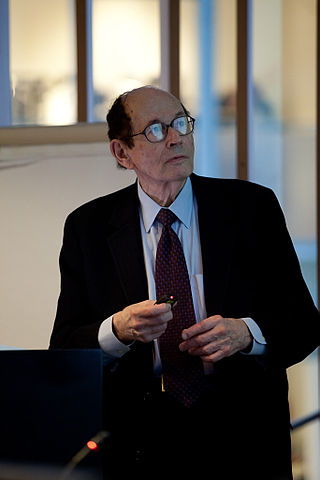Related Research Articles

Consciousness, at its simplest, is awareness of internal and external existence. However, its nature has led to millennia of analyses, explanations and debates by philosophers, theologians, linguists, and scientists. Opinions differ about what exactly needs to be studied or even considered consciousness. In some explanations, it is synonymous with the mind, and at other times, an aspect of mind. In the past, it was one's "inner life", the world of introspection, of private thought, imagination and volition. Today, it often includes any kind of cognition, experience, feeling or perception. It may be awareness, awareness of awareness, or self-awareness either continuously changing or not. The disparate range of research, notions and speculations raises a curiosity about whether the right questions are being asked.
Epiphenomenalism is a position on the mind–body problem which holds that physical and biochemical events within the human body are the sole cause of mental events. According to this view, subjective mental events are completely dependent for their existence on corresponding physical and biochemical events within the human body, yet themselves have no influence over physical events. The appearance that subjective mental states influence physical events is merely an illusion. For instance, fear seems to make the heart beat faster, but according to epiphenomenalism the biochemical secretions of the brain and nervous system —not the experience of fear—is what raises the heartbeat. Because mental events are a kind of overflow that cannot cause anything physical, yet have non-physical properties, epiphenomenalism is viewed as a form of property dualism.

Neural Darwinism is a biological, and more specifically Darwinian and selectionist, approach to understanding global brain function, originally proposed by American biologist, researcher and Nobel-Prize recipient Gerald Maurice Edelman. Edelman's 1987 book Neural Darwinism introduced the public to the theory of neuronal group selection (TNGS) – which is the core theory underlying Edelman's explanation of global brain function.

Consciousness Explained is a 1991 book by the American philosopher Daniel Dennett, in which the author offers an account of how consciousness arises from interaction of physical and cognitive processes in the brain. Dennett describes consciousness as an account of the various calculations occurring in the brain at close to the same time. He compares consciousness to an academic paper that is being developed or edited in the hands of multiple people at one time, the "multiple drafts" theory of consciousness. In this analogy, "the paper" exists even though there is no single, unified paper. When people report on their inner experiences, Dennett considers their reports to be more like theorizing than like describing. These reports may be informative, he says, but a psychologist is not to take them at face value. Dennett describes several phenomena that show that perception is more limited and less reliable than we perceive it to be.

Gerald Maurice Edelman was an American biologist who shared the 1972 Nobel Prize in Physiology or Medicine for work with Rodney Robert Porter on the immune system. Edelman's Nobel Prize-winning research concerned discovery of the structure of antibody molecules. In interviews, he has said that the way the components of the immune system evolve over the life of the individual is analogous to the way the components of the brain evolve in a lifetime. There is a continuity in this way between his work on the immune system, for which he won the Nobel Prize, and his later work in neuroscience and in philosophy of mind.

Eliminative materialism is a materialist position in the philosophy of mind. It is the idea that the majority of mental states in folk psychology do not exist. Some supporters of eliminativism argue that no coherent neural basis will be found for many everyday psychological concepts such as belief or desire, since they are poorly defined. The argument is that psychological concepts of behavior and experience should be judged by how well they reduce to the biological level. Other versions entail the nonexistence of conscious mental states such as pain and visual perceptions.
In the philosophy of mind, panpsychism is the view that the mind or a mindlike aspect is a fundamental and ubiquitous feature of reality. It is also described as a theory that "the mind is a fundamental feature of the world which exists throughout the universe." It is one of the oldest philosophical theories, and has been ascribed to philosophers including Thales, Plato, Spinoza, Leibniz, William James, Alfred North Whitehead, Bertrand Russell, and Galen Strawson. In the 19th century, panpsychism was the default philosophy of mind in Western thought, but it saw a decline in the mid-20th century with the rise of logical positivism. Recent interest in the hard problem of consciousness and developments in the fields of neuroscience, psychology, and quantum physics have revived interest in panpsychism in the 21st century.
The hard problem of consciousness asks why and how humans have qualia or phenomenal experiences. This is in contrast to the "easy problems" of explaining the physical systems that give humans and other animals the ability to discriminate, integrate information, and so forth. Such problems are called easy because all that is required for their solution is to specify the mechanisms that perform such functions. Philosopher David Chalmers argues that even if we have solved all easy problems about the brain and experience, the hard problem will still persist.
Daniel Dennett's multiple drafts model of consciousness is a physicalist theory of consciousness based upon cognitivism, which views the mind in terms of information processing. The theory is described in depth in his book, Consciousness Explained, published in 1991. As the title states, the book proposes a high-level explanation of consciousness which is consistent with support for the possibility of strong AI.
The electromagnetic theories of consciousness propose that consciousness can be understood as an electromagnetic phenomenon.
Wider than the Sky: The Phenomenal Gift of Consciousness is an English-language book on neuroscience by the neuroscientist Gerald M. Edelman. Yale University Press published the book in 2004. The book includes a glossary, a bibliographic note, and an index. The title alludes to an English-language poem written by Emily Dickinson in about 1862. In that poem, Dickinson describes the brain as "wider than the sky", "deeper than the sea", and "just the weight of God".

Animal consciousness, or animal awareness, is the quality or state of self-awareness within a non-human animal, or of being aware of an external object or something within itself. In humans, consciousness has been defined as: sentience, awareness, subjectivity, qualia, the ability to experience or to feel, wakefulness, having a sense of selfhood, and the executive control system of the mind. Despite the difficulty in definition, many philosophers believe there is a broadly shared underlying intuition about what consciousness is.

Giulio Tononi is a neuroscientist and psychiatrist who holds the David P. White Chair in Sleep Medicine, as well as a Distinguished Chair in Consciousness Science, at the University of Wisconsin. He is best known for his Integrated Information Theory (IIT), a mathematical theory of consciousness, which he has proposed since 2004.
Primary consciousness is a term the American biologist Gerald Edelman coined to describe the ability, found in humans and some animals, to integrate observed events with memory to create an awareness of the present and immediate past of the world around them. This form of consciousness is also sometimes called "sensory consciousness". Put another way, primary consciousness is the presence of various subjective sensory contents of consciousness such as sensations, perceptions, and mental images. For example, primary consciousness includes a person's experience of the blueness of the ocean, a bird's song, and the feeling of pain. Thus, primary consciousness refers to being mentally aware of things in the world in the present without any sense of past and future; it is composed of mental images bound to a time around the measurable present.

The neural correlates of consciousness (NCC) refer to the relationships between mental states and neural states and constitute the minimal set of neuronal events and mechanisms sufficient for a specific conscious percept. Neuroscientists use empirical approaches to discover neural correlates of subjective phenomena; that is, neural changes which necessarily and regularly correlate with a specific experience. The set should be minimal because, under the materialist assumption that the brain is sufficient to give rise to any given conscious experience, the question is which of its components are necessary to produce it.

In philosophy of mind, qualia are defined as instances of subjective, conscious experience. The term qualia derives from the Latin neuter plural form (qualia) of the Latin adjective quālis meaning "of what sort" or "of what kind" in a specific instance, such as "what it is like to taste a specific apple — this particular apple now".

Integrated information theory (IIT) attempts to provide a framework capable of explaining why some physical systems are conscious, why they feel the particular way they do in particular states, and what it would take for other physical systems to be conscious. In principle, once the theory is mature and has been tested extensively in controlled conditions, the IIT framework may be capable of providing a concrete inference about whether any physical system is conscious, to what degree it is conscious, and what particular experience it is having. In IIT, a system's consciousness is conjectured to be identical to its causal properties. Therefore it should be possible to account for the conscious experience of a physical system by unfolding its complete causal powers.
Secondary consciousness is an individual's accessibility to their history and plans. The ability allows its possessors to go beyond the limits of the remembered present of primary consciousness. Primary consciousness can be defined as simple awareness that includes perception and emotion. As such, it is ascribed to most animals. By contrast, secondary consciousness depends on and includes such features as self-reflective awareness, abstract thinking, volition and metacognition. The term was coined by Gerald Edelman.
Reentry is a neural structuring of the brain, which is characterized by the ongoing bidirectional exchange of signals along reciprocal axonal fibers linking two or more brain areas. It is hypothesized to allow for widely distributed groups of neurons to achieve integrated and synchronized firing, which is proposed to be a requirement for consciousness, as outlined by Gerald Edelman and Giulio Tononi in their book A Universe of Consciousness.
Consciousness is the state or quality of awareness.
References
- ↑ A Universe of Consciousness: How Matter Becomes Imagination at google books, retrieved 28 June 2014
- ↑ "Consciousness". Penguin.
- ↑ Scaruffi, Piero (2000). "A Universe of Consciousness".
- ↑ "A Universe of Consciousness". Bol.